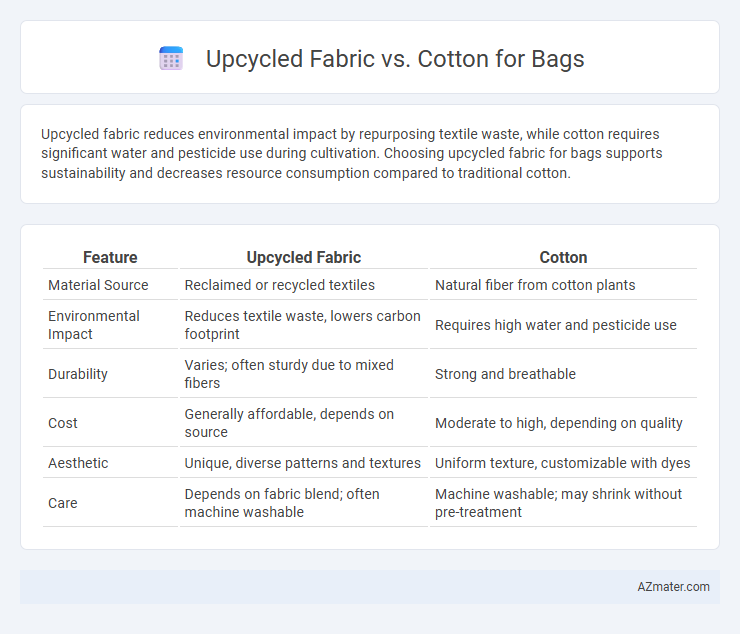Upcycled fabric reduces environmental impact by repurposing textile waste, while cotton requires significant water and pesticide use during cultivation. Choosing upcycled fabric for bags supports sustainability and decreases resource consumption compared to traditional cotton.
Table of Comparison
| Feature | Upcycled Fabric | Cotton |
|---|---|---|
| Material Source | Reclaimed or recycled textiles | Natural fiber from cotton plants |
| Environmental Impact | Reduces textile waste, lowers carbon footprint | Requires high water and pesticide use |
| Durability | Varies; often sturdy due to mixed fibers | Strong and breathable |
| Cost | Generally affordable, depends on source | Moderate to high, depending on quality |
| Aesthetic | Unique, diverse patterns and textures | Uniform texture, customizable with dyes |
| Care | Depends on fabric blend; often machine washable | Machine washable; may shrink without pre-treatment |
Introduction to Upcycled Fabric and Cotton Bags
Upcycled fabric bags are crafted from repurposed materials, reducing waste and promoting sustainability in the fashion industry. Cotton bags are made from natural fibers, offering durability and biodegradability but requiring significant water and pesticide use during cultivation. Choosing between upcycled fabric and cotton bags depends on balancing environmental impact, resource consumption, and aesthetic preferences.
Environmental Impact: Upcycled Fabric vs Cotton
Upcycled fabric significantly reduces environmental impact by repurposing existing materials, minimizing waste and lowering resource consumption compared to cotton. Cotton cultivation demands substantial water, pesticides, and land, contributing to soil degradation and pollution. Choosing upcycled fabric for bags supports sustainable production by avoiding these intensive agricultural inputs and reducing landfill waste.
Durability and Strength Comparison
Upcycled fabric often incorporates diverse textile materials, resulting in enhanced durability due to reinforced fibers and multiple fabric layers, which resist wear and tear better than standard cotton. Cotton bags, while breathable and soft, tend to weaken and fray faster under heavy use, especially when exposed to moisture and abrasion. For long-lasting strength and durability in bag construction, upcycled fabric provides a more robust and eco-friendly alternative.
Aesthetic Appeal and Design Options
Upcycled fabric offers a unique aesthetic appeal with its one-of-a-kind patterns and textures, creating visually striking, eco-friendly bags that stand out. Cotton provides versatility in design with a wide range of colors, prints, and finishes, allowing for classic and customizable bag options. The combination of sustainable upcycled materials and the design flexibility of cotton fosters innovative, stylish bags tailored to diverse consumer preferences.
Production Process and Resource Consumption
Upcycled fabric significantly reduces resource consumption by repurposing textile waste, minimizing water usage and energy compared to traditional cotton production. Cotton cultivation demands vast amounts of water, pesticides, and land, contributing to environmental degradation and high carbon emissions. The production process of upcycled fabric relies on existing materials, offering a sustainable alternative that lowers environmental impact and supports circular economy principles.
Cost Analysis: Upcycled vs Cotton Bags
Upcycled fabric bags typically offer a cost advantage over cotton bags due to lower raw material expenses, as they repurpose existing textiles instead of relying on new cotton production. Cotton bags involve higher costs attributed to farming, water usage, and processing, resulting in a higher price point. This cost differential makes upcycled bags an economically attractive option for sustainable and budget-conscious consumers.
Ethical and Social Considerations
Upcycled fabric for bags significantly reduces textile waste, promoting sustainability and ethical consumption by repurposing discarded materials, which minimizes environmental impact compared to conventional cotton production. Cotton cultivation often involves high water usage, pesticide application, and labor-intensive processes that can exploit workers and strain ecosystems in developing regions. Choosing upcycled fabric supports circular fashion initiatives and fair labor practices, aligning with social responsibility goals for eco-conscious consumers.
Maintenance and Care Requirements
Upcycled fabric bags require minimal maintenance, often needing only spot cleaning due to their diverse material blends, which enhances durability and reduces water use. Cotton bags demand regular washing to prevent odor and dirt buildup, but they can shrink or lose shape if not washed carefully in cold water and air-dried. Both materials benefit from avoiding harsh chemicals, yet upcycled fabric's variability may require tailored care instructions depending on the source fabric composition.
Market Trends and Consumer Preferences
Market trends reveal a growing consumer shift towards upcycled fabric bags driven by sustainability and eco-conscious values, with a projected CAGR of 7.2% in the next five years. Cotton bags maintain popularity for their natural fiber appeal and biodegradability, yet face challenges from environmental issues linked to water consumption and pesticide use in cotton farming. Consumer preferences increasingly favor upcycled materials for their unique aesthetics and lower carbon footprint, positioning them as a preferred choice in ethical fashion markets.
Which is Better for Bags: Upcycled Fabric or Cotton?
Upcycled fabric offers a sustainable and eco-friendly alternative to traditional cotton, reducing waste and lowering environmental impact by repurposing existing materials. Cotton bags, while durable and widely available, often require significant water and pesticide usage during cultivation, affecting their ecological footprint. Choosing between upcycled fabric and cotton depends on prioritizing sustainability goals versus material consistency and availability for bag production.

Infographic: Upcycled fabric vs Cotton for Bag
 azmater.com
azmater.com